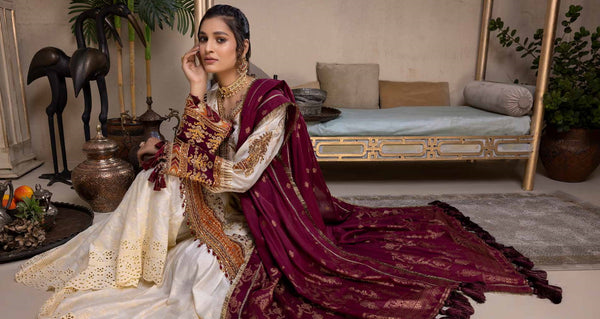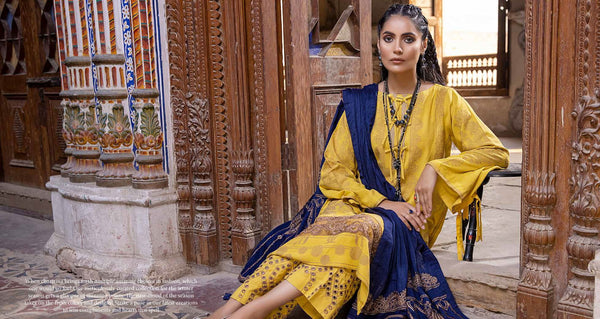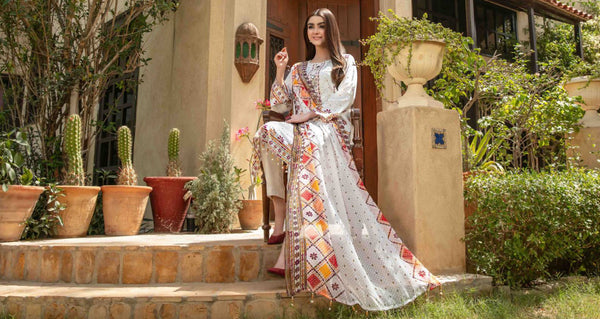November 13, 2021
Sarees: A Guide To India's Most Iconic Dress
Hundreds, if not thousands of dresses have made their mark on the Indian fashion scene. But only a few have stood the test of time and have kept women coming back to them like the saree. The story of the saree is unlike any other; simple yet so glamorous.
The saree, specifically the unstitched piece of nine-yard fabric enjoys the attention of women and girls across the length and breadth of India. And while you might be eager to add one or more of these highly versatile dress pieces to your wardrobe, this post goes into the details of everything saree - the history, style guide, and all.

Embroidered Saree in Beige Color
What is the Indian Saree?
The saree itself is a rectangular piece of fabric with a length that could range from about five (5) to nine (9) yards. To wear the saree, it’s usually wrapped around the waist. One end of the saree will then be draped across the shoulder in a way baring the midriff section.
The saree ensemble includes a petticoat usually worn under the dress alongside a fitted upper garment (a blouse) and the saree itself.
The saree’s simplicity gives it a kind of versatility that continues to amaze everyone. It can be draped in dozens of different ways and styles. And while it’s become almost the most important piece in Indian fashion, the saree’s influence extends even beyond fashion as it can often be used as an heirloom passed down across generations of women in India.

Women Wearing a Red Saree
History of the Saree
The history of the Saree goes way back to the Indus Valley Civilisation era of northwest Indian around 2800–1800 BC. the story perhaps, starts with the cultivation and weaving of cotton which grew rapidly in that era around the 5th millennium BC. Cotton weavers of that era began the saree revolution using dyes of different kinds from turmeric to red madder, lac, indigo, and more to make the drape used by women.
The saree started its humble beginning as nothing more than just a simple drape to help the women of that era cover their modesty. But that simple drape soon became an important piece of our fashion.
Over time, people began incorporating several styles and designs into making the sari with richer women often preferring their sari done with gold embroidery and other expensive stones. However, one of the most intriguing aspects of a saree design till today remains how it has won the love of different women across different age groups and social strata everywhere across India.

Yellow Saree with Embroidery Work
Saree Style Guide
Now, you know the story of the saree and how it came to be.
But how can you choose the best one you need?
The good thing about sarees is the fact they’ll look good on any woman regardless of their body type. Whether you’re a short, tall, skinny, apple-shaped, plus-sized woman, etc., there’s always a saree for your body shape, height, and complexion.
Saree fabrics range from cotton to georgette, chiffon, net, silk, organza, etc. whatever you’re doing with saree, keep these five things in mind;
- Pair heavy sarees with lighter blouses, and vice versa.
- Be sure your pleating is done nicely so the entire dress doesn’t have to look shabby
- In choosing accessories, avoid going overboard so the accessories don’t negatively overwhelm your look.
- Cotton sarees, tissue sarees, and other types of sarees that need to be starched should be properly ironed.
- Saree pleats should be neatly done and tucked in so you can look smart and beautiful.
The saree is perhaps the Indian woman’s best friend as far as fashion and style are concerned. This relationship is simple, yet so strong; subtle, yet so powerful.
More than just garments, sarees have achieved symbolic status in India and are seen more as a symbol of femininity. They come in all kinds of fabrics, can be styled in a myriad of ways. Women love the saree because it helps them look effortlessly chic and beautiful.
← Back to Blogs
Also in Indian Fashion
INFORMATION
FABRICOZ HELP






